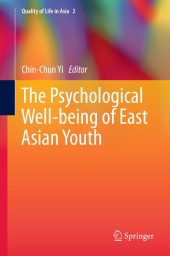 Neuerscheinungen 2014Stand: 2020-02-01 |
Schnellsuche
ISBN/Stichwort/Autor
|
Herderstraße 10
10625 Berlin
Tel.: 030 315 714 16
Fax 030 315 714 14
info@buchspektrum.de |

Chin-Chun Yi
The Psychological Well-being of East Asian Youth
Herausgegeben von Yi, Chin-Chun
2013. 2014. x, 346 S. 33 SW-Abb.,. 235 mm
Verlag/Jahr: SPRINGER NETHERLANDS; SPRINGER 2014
ISBN: 9400799659 (9400799659)
Neue ISBN: 978-9400799653 (9789400799653)
Preis und Lieferzeit: Bitte klicken
Based on the most recent data from Taiwan, this book provides readers with a comprehensive picture of the diverse growth trajectories experienced by East Asian youth as they progress from early adolescence to adulthood in a rapidly changing social environment.
The rapid social change in the East Asia has brought great research attention on the family, education and political impacts. The growth trajectory of the next generation is exposed to an entirely different context owing to the dual effects of traditional and modern values as well as practices. This book provides an overall picture of the developmental trajectory of Taiwanese youth as a typical example in the region. The time frame is set from early adolescence (13years old) to young adulthood (22yeard old). Individual psychological well-being in its broad definition will be used as the outcome indicator to reflect significant developmental processes during this important transitional life course.
Benefitted from the rare panel datasets conducted from 2000-2009, this book has two major focuses: one is to explore the interplay among family, school and community with regard to their influence on the individual growth patterns; the other is to highlight the potential constraint and/or strength of the prevailing social norms and values shared among East Asian societies. To be specific, different chapters will describe and analyze the life chances and growth patterns among youth with different social capitals (including family SES, educational achievement, rural-urban residence, etc.). Their short-term versus long-term outcome, as indicated by various psychological well-being variables (e.g., depressive symptoms, deviant or problem behaviors, happiness, edutional performance), will allow us to delineate the particular structural context that individual East Asian youth encounters and to offer constructive suggestions on family interaction, educational strategy as well as health related policies based on the scientific evidence.
This book incorporates comparative reports from other East Asian societies, and from youth panel studies of Australia and the U.S.. The experience of their counter-part in the advanced societies will contribute to readers´ understanding of the particular social situation that East Asian youth is embedded in the growth process. In addition, comparative perspective will enable the reader to contemplate on the potential future development of the affluent generation in the region. Since changing social structure occurred in the last few decades in the East Asia has suffered inadequate investigation in the realm of family, education and community, this book provides timely information to fill up the gap. Analyses of the valuable dataset from early adolescents to young adults will attract those who are interested in family researches, in youth studies, in panel data analyses, as well as in the social development in Taiwan and in East Asia.


